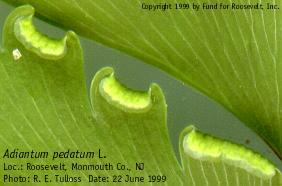| Adiantum Earlier placement: | ||
Maidenhair fern | ||
|
Etymology
Adiantum is from the Greek, adiantos, meaning unwettable, referring to the water-repellent fronds.
Description
Rhizome: suberect to long-creeping, absent or hairy or scaly.
Frond: deciduous, monomorphic. Stipe: chestnut brown to dark purple, grooved above, glabrous or few scales, vascular bundles: 1 or 2. Blade: 1-3 pinnate or pedate, lanceolate, ovate, trowel-shaped, or fan-shaped, membranaceous to papery, commonly glabrous. segments round, fan-shaped, rhombic, or oblong with marginal teeth, lacking a midrib, veins free, forking. Sori: sporangia, submarginal, indusium: false, inrolled margins, sporangia: yellow or yellowish brown.
Distinctive Characteristics
FNA states that sporangia borne on the lower surface of the false indusium are both necessary and sufficient to define the genus. However, lacking a high-powered lens, the amateur will need additional criteria. The lack of a midrib in the ultimate segments is unique among the hardy ferns here.
|
|
|
